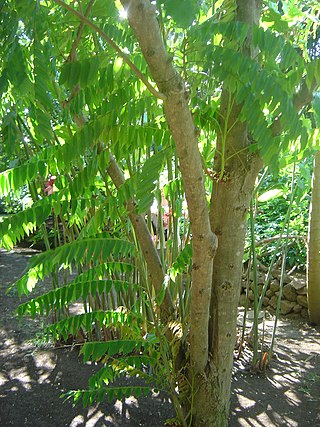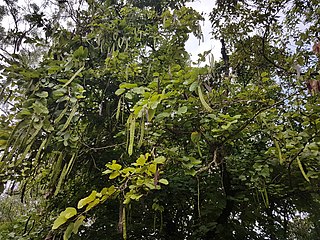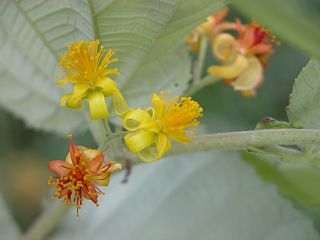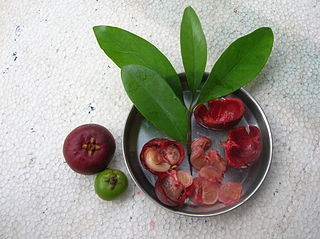
Mangosteen, also known as the purple mangosteen, is a tropical evergreen tree with edible fruit native to tropical lands surrounding the Indian Ocean. Its origin is uncertain due to widespread prehistoric cultivation. It grows mainly in Southeast Asia, southwest India and other tropical areas such as Colombia and Puerto Rico, where the tree has been introduced.

Garcinia is a genus of flowering plants in the family Clusiaceae native to Asia, America, Australia, tropical and southern Africa, and Polynesia. The number of species is disputed; Plants of the World Online (POWO) recognise up to 400. Commonly, the plants in this genus are called saptrees, mangosteens, or garcinias, and is one of several plants known as by the name "monkey fruit".

Garcinia gummi-gutta is a tropical species of Garcinia native to South Asia and Southeast Asia. Common names include Garcinia cambogia, as well as brindle berry, and Malabar tamarind. The fruit looks like a small pumpkin and is green to pale yellow in color.

Averrhoa bilimbi is a fruit-bearing tree of the genus Averrhoa, family Oxalidaceae. It is believed to be originally native to the Maluku Islands of Indonesia but has naturalized and is common throughout Southeast Asia. It is cultivated in parts of tropical South Asia and the Americas. It bears edible extremely sour fruits. It is a close relative of the carambola tree.

Sinigang is a Filipino soup or stew characterized by its sour and savory taste. It is most often associated with tamarind, although it can use other sour fruits and leaves as the souring agent. It is one of the more popular dishes in Filipino cuisine. The soup is usually accompanied by rice. In 2021, sinigang was rated as the world's best vegetable soup by TasteAtlas.

Bauhinia purpurea is a species of flowering plant in the family Fabaceae, native to the Indian subcontinent and Myanmar, and widely introduced elsewhere in tropical and subtropical areas of the world. Common names include orchid tree, purple bauhinia, camel's foot, butterfly tree, and Hawaiian orchid tree.

Sandoricum koetjape, the santol, sentul or cotton fruit, is a tropical fruit native to maritime Southeast Asia (Malesia).

Grewia asiatica, commonly known as phalsa or falsa, is a species of flowering plant in the mallow family Malvaceae. It was first found in Varanasi, India, and was taken by Buddhist scholars to other Asian countries including Pakistan and the rest of the world. Grewia celtidifolia was initially considered a mere variety of phalsa, but is now recognized as a distinct species.

Garcinia dulcis is a tropical fruit tree native to the Philippines, Java, Lesser Sunda Islands, eastern Indonesia, and Papua New Guinea. It was domesticated early and spread inland into mainland Asia. It is commonly known as mundu or munu in Indonesia and Malaysia, baniti or taklang-anak in the Philippines, and maphuut or ma phut in Thailand.

Garcinia morella is a species of tree in the family Clusiaceae found in India, and Sri Lanka.

Garcinia atroviridis, known as asam gelugur, asam gelugo, or asam keping is a large rainforest tree native to Peninsular Malaysia and Sumatra. This species grows wild throughout Peninsular Malaysia but is also widely cultivated, especially in the northern states, owing to its economic and medicinal value. Garcinia atroviridis is a large perennial plant commonly found in evergreen forests in the southern region of Thailand and Malaysia.

Garcinia indica, a plant in the mangosteen family (Clusiaceae), commonly known as kokum, is a fruit-bearing tree that has culinary, pharmaceutical, and industrial uses. It primarily grows in the Western Ghats, especially the Goa and Konkan region.

Artocarpus camansi, the breadnut, is a species of medium-sized tree in the family Moraceae. It is native to New Guinea, the Maluku Islands, and the Philippines. It is the wild ancestor of the breadfruit (Artocarpus altilis) and is also sometimes known as the seeded breadfruit, to distinguish it from its mostly seedless descendant. Breadnut fruits are edible when cooked. The large seeds can also be roasted and eaten.

Garcinia pedunculata is an evergreen tree related to the purple mangosteen. The tree is endemic to the south-eastern regions of Asia such as parts of Myanmar, Bangladesh and north-eastern parts of India. It is popularly known in India as Amlavetasa, in Bangladesh as Thoikor or Taikor and in Assam as Bor Thekera.

Hot and sour soup is a popular example of Sichuan cuisine. Similar versions are found in Henan province, near Beijing, and in Henan cuisine itself, where it may also be known as hulatang or "pepper hot soup" (胡辣汤). Also popular in Southeast Asia, India, Pakistan and the United States, it is a flexible soup which allows ingredients to be substituted or added depending on availability. For example, the American-Chinese version can be thicker as it commonly includes corn starch, whilst in Japan, sake is often added.
Garcinia parvifolia, the Kundong, Brunei cherry or Asam aur aur, is a tropical evergreen tree native to Borneo, Peninsular Malaysia, Sulawesi and Sumatra. The tree is found at elevations of 600–800 metres (2,000–2,600 ft) in humid environments, and grows to a height of 33 metres (108 ft). The bark, wood, leaves, and fruit of the kundong tree are used by humans.

Garcinia xanthochymus, the false mangosteen, gamboge, yellow mangosteen, Himalayan Garcinia, or sour mangosteen is a species of mangosteens found from India, southern China, and Japan through Indochina to Peninsular Malaysia at elevations of 0 - 1400 meters. Plants are found growing in humid forests of valleys or on hills. It is locally known as defol (ডেফল) in Bengal, tepor tenga in Assam, and heirangoi (হৈরাংগোই) in Manipur.
Inubaran is a Filipino chicken stew or soup made with chicken cooked with diced banana pith, coconut milk (gata) or coconut cream, a souring agent, lemongrass, and various spices. The souring agent is traditionally either batuan fruits or libas leaves. The name means "[cooked] with ubad ", not to be confused with ubod ; although ubod can sometimes be used as a substitute for ubad which can be difficult to acquire. It originates from the Western Visayas and is associated with the cuisines of the Aklanon people. Variants of the dish can also be made with other types of meat or seafood. It is a type of ginataan.

Garcinia sessilis, commonly known as heilala in Tongan, is an evergreen tree native to the Pacific regions of Solomon Islands, Fiji, Samoa and Tonga. The heilala flower is the national flower of Tonga.

Garcinia talbotii is a large tree in the family Clusiaceae and is endemic to the Western Ghats of India. The tree has yellow latex, and can attain a height of 25 m and girth up to 2.2 m. This species was first reported from Gairsoppah Ghats in North Kanara of Karanataka district.

















